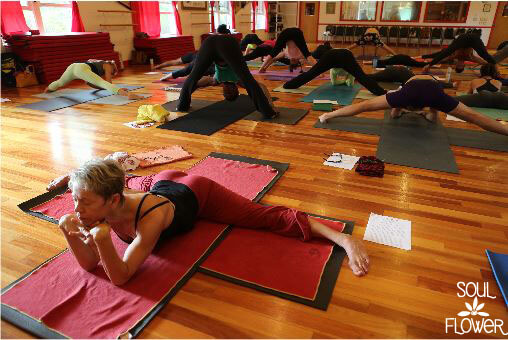Ballet dancers always look composed and ethereal, but have you ever put on a pair of pointe shoes? Those things are agony on the feet!
Somehow though, dancers create an illusion of relaxed grace through not only their limber bodies, but also through their unaffected, elegant facial expressions.Yoga practitioners too, can create pretzel-like shapes with their bodies, but because their focus is turned inward toward the peaceful nature of the soul, the postures (asanas) look easy and effortless. In reality, they are difficult and require (same as in ballet) strength, discipline and practiced conditioning.
The fact that the body can be conditioned (through practice) to move through space with the grace and ease of a ballet dancer or an accomplished yogini while maintaining a peaceful outward composure means that any human can be one thing outwardly and quite another internally. Could happiness (when we are decidedly unhappy) begin with practice and external conditioning?
MAY COOLER HEADS PREVAIL
In 1989, an important research discovery was made by psychologist Dr. Robert Zajonc. He based some of his hypothesis on Darwin’s 19th century theory that facial expressions don’t just reflect emotions, they can cause them. In the course of his research, Zajonc identified the internal carotid artery as , the so-called “pipe” that delivers most of the blood to the brain, as having an important role in pairing facial expression with emotion. The carotid artery flows through a structure called the cavernous sinus which contains many facial veins (and important nerves). So, when someone smiles (and their fascial muscles tighten/stretch), veins are constricted and blood flow to the brain decreases causing the brain to “cool down”.
Less blood flow = less heat to the head! Apparently a “cooler brain” triggered a feeling of joy and happiness. The reverse proved to be true too. When facial muscles contracted into a frown, blood flow to the brain increased (warming the brain with more blood) and feelings of happiness decreased.
A MEDITATION SECRET OF THE YOGI
Several ancient texts of yoga (like Hatha Yoga Pradipika) make reference to the “adamantine body”. It’s not at all about your physical body, but rather what the yogis called the “astral body”. The adjective “adamantine” (think diamond) refers to the resulting cool, stable and crystal-clear mind experience that practitioners describe after engaging in deep tantric meditation techniques. In modern terms this “adamantine body” or “astral body” is your central nervous system (CNS). It is composed of the spinal cord, brain and the cerebral spinal fluid (CSF) flowing through the CNS channels and brain ventricles. The ancient sages and practitioners from thousands of years ago apparently knew ALL about “cool heads” making the wisest choices in life. They deliberately cultivated those profound adamantine effects in order to personal mastery over the energy flowing through the CNS. That mastery gave them moksha – freedom from the suffering of the material world caused by negative thoughts, attitudes, emotions and behaviors. Their “cool heads” gave them wisdom and happiness from within.

FAKE-IT-TIL-YOU-MAKE-IT
Not many people have the time or discipline to gain real mastery over their nervous system. And pasting on a smile when you feel terrible may not be authentic. Yet think about it….. how many times have you been sad, depressed or upset and then had to “put on a brave face” only to realize that the faking of the brave face actually creates it! Allowing your internal space to catch up to your outward expression isn’t fool-proof, but it’s an excellent place to start feeling better. So smile, and be peaceful! Let happiness land on your face! You will get chill, feel better and make the world a better place in the process.
Mara wore the A Thousand Petals Ebb & Flow Top & Flow Mandala Pants
![]()




Burnell Yow!
August 19, 2015 at 12:21 am (10 years ago)Excellent post! And so true. Smiling is powerful. Laughing, too.